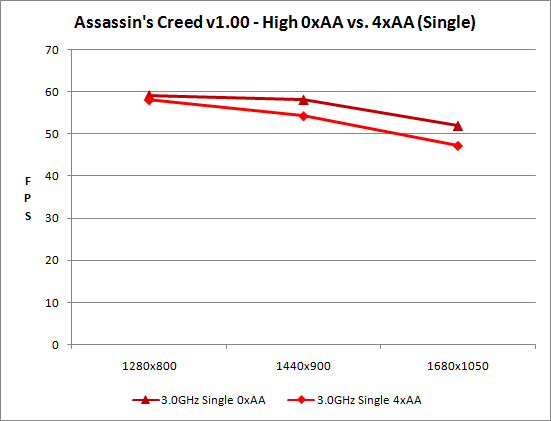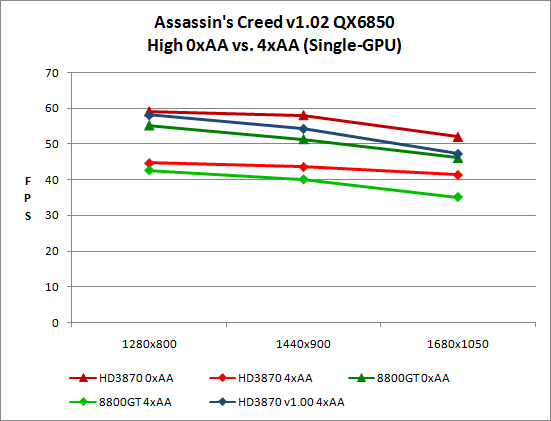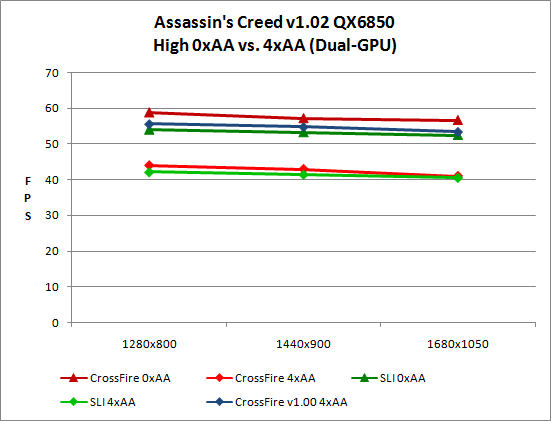Further Anti-Aliasing Investigations
When it comes to anti-aliasing in AC, the heart of the matter is the differences in graphics architectures. ATI's current GPUs do not have dedicated anti-aliasing hardware. Instead, they rely on the pixel shaders to achieve the same result. Depending on the type of graphics work being done, this approach can have a negative impact on performance. ATI seems to have gotten around this via some of the extensions to DirectX 10.1. NVIDIA graphics chips do include anti-aliasing hardware, but that hardware cannot be properly utilized in some situations. Specifically, there are post-rendering effects that interfere with the use of anti-aliasing hardware -- that's why some games don't support anti-aliasing at all.
If you haven't figured it out already, there is a universal "solution" for applying anti-aliasing effects that doesn't depend on the use (or non-use) of other shader effects. The solution is to use pixel shaders. ATI has apparently decided that's the most practical solution as we move forward and SM 3.0/SM4.0 usage increases, but it does require work on the part of software developers. Another downside to this approach is that it requires more work from the pixel shader hardware, which can result in lower performance. However, it seems the only other option is to omit anti-aliasing in certain types of graphics rendering.
With all that out of the way, let's look at the performance of AC with and without anti-aliasing at several different resolutions. Unfortunately, as previously mentioned we are unable to test anti-aliasing at higher resolutions because the option is disabled inside the game.




We can see the result of using pixel shaders to do anti-aliasing in the resulting performance drop. What's noteworthy is that the drop isn't nearly as bad on ATI hardware running AC version 1.00. In other words, the 1.02 patch levels the playing field and forces ATI and NVIDIA to both use an extra rendering pass in order to do anti-aliasing. That probably sounds fair if you're NVIDIA -- or you own NVIDIA hardware -- but ATI users should be rightly upset.
Something else that's interesting to see is how performance is definitely CPU limited even with a quad-core 3.0GHz Intel chip. We will look at that next, but right now we are more interested in the steady drop caused by anti-aliasing. If the CPU is the bottleneck, putting more of a load on the GPU should not impact performance much. For whatever reason, it seems that the extra rendering pass required for anti-aliasing causes a steady drop in performance even when we're CPU limited. Have we mentioned yet that you really need some beefy hardware in order to play AC at higher detail settings?










32 Comments
View All Comments
geogaddi - Tuesday, June 10, 2008 - link
...now, what did i do with that babelfish...
ssgoten00 - Monday, June 2, 2008 - link
AC was only an average game overall. Graphics presentation was it's strong suit but gameplay was lacking and the game seemed to drag on as the player progresses through the game. Undoubtedly the repetitiveness was the worst part of AC. Not simply the fact that is seemed like some tasks were a redue of previously accomplished tasks but the shear fact that tasks were repeated verbatim with same characters and voices, only changing dialogue to create variation. Some characters players will have to kill multiple times under the guise of actually killing different characters in the game. AC was also disappointing in the fact that it mislead gamers in presenting its self a a somewhat stealth game. Nothing could be further from the truth. In AC players will often be forced into full on combat with multiple opponents to progress in the storyline. In vary select situations players have the choice of using stealth as a viable option. Ironically the last 5 or 10 minutes at the very end of the game are the most compelling. After the credits roll players are left in the main room to explore and decrypt code and hidden messages. It's unfortunate AC's developers couldn't have spent more time on puzzles that actually pertained to gameplay. Out of a possible 10 I give Assassin's Creed a 6.0 barely coming in at par, bordering on subpar.Donkey2008 - Monday, June 2, 2008 - link
It does have a Thief feel but after playing it on Xbox, I found it to be more Thief meets BloodRayne meets Splinter Cell with some of the best graphics I have seen in a while. It is sorta repetitive,but the violence cut away any boredom I had. I enjoyed it a lot.But I guess they could have done what other Rockin high-profile companies do and make an even more repetitive game exactly like its previous versions, but with a much worse soundtrack. Throw in some terribly low-res character models and reuse the same, bottom-of-the-barrel, cartoon-looking cutscenes and they would have a perfect 10 as well.
poohbear - Monday, June 2, 2008 - link
this is the kind of game reviews i'd like to see, wherein hardware is tested w/ a game to show performance. I mean, you guys ARE a hardware site and there are'nt many sites that do game reviews w/ hardware testing shortly after. I dont think u should do game reviews without hardware testing cause there are a ton of game review sites, but your niche shines when you do these hardware and DX analysis. cheers and thanks for a very informative article.DesertCat - Monday, June 2, 2008 - link
The article talks about wanting to check the performance of Assassin's Creed on a Phenom processor (and its 4 cores). I can speak to that to some degree.I have a Phenom 9600 (2.3 MHz) on an AM2 board (Asus M2N-SLI Deluxe) with an EVGA 8800GT OC (650 MHz). I play at 1280x1024 so I play in a letterbox mode. This processor is enough to run the game at acceptable frame rates but I would tend to think that a fast dual core would do just as well (like was found with the Intel processors in the article).
With the performance hurting TLB patch enabled, I noticed one area where frame rates truly took a nosedive: when doing the "look" pan from the top of one of those towers. I didn't have an fps counter on at the time, but I'm guessing it was in the 12-16 fps range based on the chunkiness I experienced. I got similar slow framerates when diving from those spots into the hay (especially the really high towers).
With the TLB patch disabled on my Phenom, those two low fps spots were much better. I'm guessing that those areas were in the low 20's of fps. The rest of the game was smooth as silk and probably above 40 fps. I do not, however, see high utilization on any particular core when I've checked.
If I was to point to areas that really stress a system in AC, I would say that the tower pan shots are the most common. (*minor spoiler ahead*) King Richard's speech from horseback about 3/4 the way through the game is also very intensive.
aguilpa1 - Monday, June 2, 2008 - link
I know I've had it for a long time?emboss - Monday, June 2, 2008 - link
The word you *are* looking for is possibly letterboxing?PrinceGaz - Monday, June 2, 2008 - link
I was going to mention that as well. Anamorphic means the pixels making up the image are stretched either horizontally (as with wide-screen DVDs) or vertically when displayed. If the game were anamorphic, it would be like it running on a monitor at 1920x1080 but being rendered internally at some other resolution such as 1440x1080 and stretched to the displayed 1920x1080.The correct description is what you said originally, that it allows only a 16:9 aspect-ratio view, so if I ran it on my monitor (1600x1200 native) the game itself would only use the central 1600x900 of that.
JarredWalton - Tuesday, June 3, 2008 - link
Sorry - I saw the original comment and thought I corrected it. Missed the other two occurrences. I wasn't thinking and just used the word after reading the thread on widescreengamingforum.com about AC. (I was hoping someone had found a way around the locked letterbox view.)AnnihilatorX - Monday, June 2, 2008 - link
This review is great! I have never read a game review that includes all the analysis, benchmarks, gameplay video conveniently presented.Excellent work!